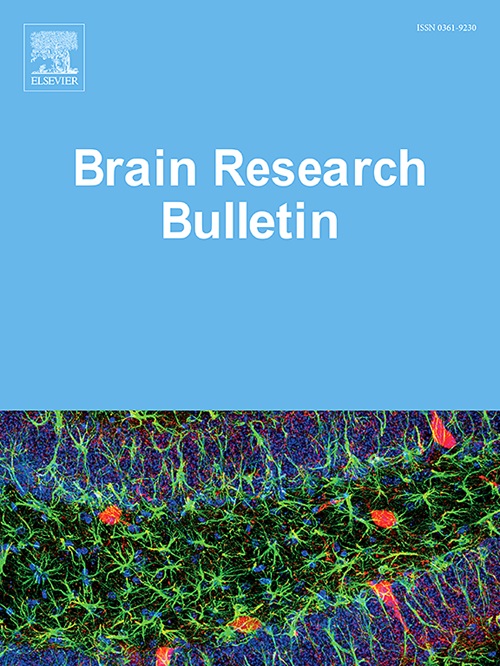Application of TCM network pharmacology and experimental verification to explore the mechanism of kaempferol against epilepsy
IF 3.5
3区 医学
Q2 NEUROSCIENCES
引用次数: 0
Abstract
Background
Kaempferol (KF), the main active ingredient in identifying the authenticity of safflower, has a variety of pharmacological activities and neuroprotective effects. However, the mechanism of KF in the treatment of epilepsy remains unclear. This study aimed to investigate the protective effects of KF on epilepsy and its related mechanisms.
Methods
Network pharmacology was used to explore the targets and mechanisms of safflower antiepileptic action. The protective effect of KF on epilepsy was assessed in the behavior and tissues of epileptic mice. Additionally, the impact of KF on the excitability and calcium transients of rat cortical neurons and α-amino-3-hydroxy-5-methyl-4-isoxazole-propionicacid receptor (AMPAR) were investigated using patch clamp and calcium imaging techniques.
Results
Network pharmacology indicated safflower could be involved in calcium signaling pathways and calcium channel inhibitor activity. Experimental validation demonstrated that KF delayed seizure onset and mitigated neuronal damage in the prefrontal cortex of mice. It also reduced neuronal excitability, as indicated by action potential parameters, and suppressed Glutamate (Glu)-induced calcium transients. In tsA201 cells, KF inhibited AMPAR-mediated currents, suggesting a role in regulating [Ca2+]i homeostasis.
Conclusion
These results indicate that KF's anticonvulsant properties may arise from its neuroprotection against cell injury, edema, and necrosis, its reduction of neuronal hyperexcitability, and its prevention of calcium-induced cytotoxicity, potentially involving AMPAR modulation. This study positions KF as a promising candidate for epilepsy therapy, offering a scientific foundation for its clinical investigation.
应用中医网络药理学及实验验证探讨山奈酚抗癫痫作用机制
山奈酚(KF)具有多种药理活性和神经保护作用,是鉴别红花真伪的主要有效成分。然而,KF治疗癫痫的机制尚不清楚。本研究旨在探讨KF对癫痫的保护作用及其机制。方法采用网络药理学方法,探讨红花抗癫痫作用的靶点和机制。通过观察癫痫小鼠的行为和组织,评价了KF对癫痫的保护作用。此外,利用膜片钳和钙成像技术研究了KF对大鼠皮层神经元兴奋性和钙瞬态以及α-氨基-3-羟基-5-甲基-4-异恶唑-丙酸受体(AMPAR)的影响。结果网络药理学表明红花可能参与钙信号通路和钙通道抑制剂活性。实验证实,KF可延缓癫痫发作,减轻小鼠前额叶皮层神经元损伤。它还降低了神经元的兴奋性,如动作电位参数所示,并抑制了谷氨酸(Glu)诱导的钙瞬态。在tsA201细胞中,KF抑制ampar介导的电流,提示其在调节[Ca2+]i稳态中的作用。结论KF的抗惊厥作用可能来自其对细胞损伤、水肿和坏死的神经保护作用,降低神经元的高兴奋性,预防钙诱导的细胞毒性,可能与AMPAR调节有关。本研究为KF治疗癫痫提供了良好的候选药物,为其临床研究提供了科学依据。
本文章由计算机程序翻译,如有差异,请以英文原文为准。
求助全文
约1分钟内获得全文
求助全文
来源期刊

Brain Research Bulletin
医学-神经科学
CiteScore
6.90
自引率
2.60%
发文量
253
审稿时长
67 days
期刊介绍:
The Brain Research Bulletin (BRB) aims to publish novel work that advances our knowledge of molecular and cellular mechanisms that underlie neural network properties associated with behavior, cognition and other brain functions during neurodevelopment and in the adult. Although clinical research is out of the Journal''s scope, the BRB also aims to publish translation research that provides insight into biological mechanisms and processes associated with neurodegeneration mechanisms, neurological diseases and neuropsychiatric disorders. The Journal is especially interested in research using novel methodologies, such as optogenetics, multielectrode array recordings and life imaging in wild-type and genetically-modified animal models, with the goal to advance our understanding of how neurons, glia and networks function in vivo.
 求助内容:
求助内容: 应助结果提醒方式:
应助结果提醒方式:


